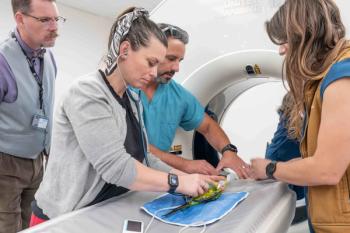
Abdominal viscera: disease processes defined with radiology and ultrasound (Proceedings)
Radiology is like standing on the outside of the building; it allows you to see the size, shape and contour of the building; ultrasound allows you to look into each room in the building i.e. the liver room, the gallbladder room, the pancreas room, the kidney room, the urinary bladder room etc.Indications for radiographic examination
• For visualization of soft tissue structures, radiology and ultrasound are complimentary.
• Analogy: Radiology is like standing on the outside of the building; it allows you to see the size, shape and contour of the building; ultrasound allows you to look into each room in the building i.e. the liver room, the gallbladder room, the pancreas room, the kidney room, the urinary bladder room etc.
Indications for radiographic examination
• Overview
• Size, shape, position, contour, opacity
• Very good for bone and gas-skeletal system, lungs
• Contrast studies-GI series, IVU, cystourethrogram, vaginogram enhance ability to define structures.
• Can only see four opacities-gas, fat, bone and "soft tissues"
• Need one opacity surrounding something of a different opacity to be able to define it radiographically
Indications for ultrasound examination
• Individual soft tissue organ composition
• Dynamic blood flow
• Not so good for bone and gas
Abdominal cavity
A. Method of choice for detecting the etiology for peritoneal fluid.
1. Fluid acts as "acoustic window/contrast medium"; THE FLUID ENHANCES THE ABILITY TO visualize intra-abdominal structures.
2. Abdominal masses can be assessed despite the presence of hemorrhage.
3. The liver can be evaluated, especially its architecture and contour.
4. Focal Lesions-Metastasis, nodular hyperplasia CAN BE SEEN.
5. Mass lesions-abscess, cysts, neoplasia can be seen.
6. Hepatic congestion can be defined.
7. Vascular abnormalities-shunts, av fistula can be defined
8. Cirrhosis may be defined.
Comparison â ultrasonic image to radiographic image
B. Hepatobiliary system-indicated in presence of jaundice
1. Cholelithiasis
2. Extra-hepatic biliary obstruction, enlarged common bile duct
3. Enlargement of intrahepatic bile ducts
4. Neoplasia involving biliary system
5. Obstruction due to pancreatic disease
Echogenic Scale Of Organ Systems From Black To White
C. Spleen-indicated in presence of splenomegaly and blood dyscrasias
1. Torsion
2. Neoplasia
3. Nodular hyperplasia
4. Infection
5. Infarction
6. Hematoma
D. Urogenital system
1. Pregnancy diagnosis 18-25 days post-breeding
2. Fetal viability-heart rate, gi motion, overall motion.
3. Ovarian masses, cysts
4. Infertility
5. Pyometra/hematometra
6. Ovarian pedicle and uterine stump pyogranuloma
7. Scrotal enlargement-neoplasia, hydrocele
8. Location of retained testicle
9. Prostate gland-hyperplasia, cysts, abscesses, neoplasia
10. Kidneys-neoplasia, cysts, abscesses, hydroureteronephrosis, glomerulonephrosis/ nephritis, mineral deposition/calculi, toxicosis, fibrosis, hypoplasia/dysplasia
11. Urinary bladder-neoplasia, infection, neoplasia, wall thickness
E. Other
1. Pancreas-neoplasia, pancreatitis
2. Adrenal glands-hyperplasia, neoplasia
3. Gastrointestinal tract-neoplasia, intussusception, infiltrative diseases
4. Lymph nodes-mesenteric, retroperitonel enlargement
5. Peritoneum-carcinomatosis, mesenteric masses
6. Retroperitoneum-effusion, hemorrhage, lymph node enlargement
7. Hernia-diaphragmatic, pericardial-peritoneal, body wall
8. General abdominal survey
Things I have learned:
Radiology:
• This technology uses ionizing radiation and thus it can potentially harm the patient.
• The conventional radiographic study allows for the overall appreciation of opacity, size, shape, position and contour of many, but not all, of the abdominal viscera.
• It is a cost-effective method to obtain an "overall" appreciation of many organs.
• What can be visualized in a survey radiographic study is very dependent on image quality and the composition of the structures being imaged.
• There needs to be approximately 35% difference between two adjacent soft tissue structures in the absorption/transmission of x-rays with conventional radiology to be able to appreciate these structures as distinct entities.
• Four opacities can be visualized radiographically-gases, fat, soft tissues and bone.
• All of the soft tissues are approximately the same opacity; as such, adjacent soft tissues cannot be distinguished distinctly in the conventional radiographic study.
• Contrast media-gas, barium and iodinated water soluble media are used to change the opacity of tissues; thus allowing them to be visualized using this imaging method.
• The imaging detail obtainable in the conventional radiographic study is hampered by superimposition of structures.
• With digital technology, the image can be manipulated electrically-sometimes for better and sometimes for worst.
Ultrasound:
• This technology does not use ionizing radiation.
• The ultrasound study is a cost-effective imaging method to assess the composition of "soft tissues".
• The ultrasound study is hampered by gas, bone, metal and barium.
• Not all soft tissue structures are easily defined-the right adrenal gland, ureters and pancreas can be very difficult to visualize.
• The imaging quality is very user dependent.
• The imaging quality is often equipment dependent.
• The imaging quality may be patient dependent.
• In additional to defining size, shape, position and contour, the ultrasound study allows you to assess the "echotexture" of the soft tissue structures being imaged.
• There are four echotextures-anechoic, isoechoic, hypoechoic and hyperechoic.
• A cellular lesion in a cellular organ of the same echotexture i.e. isoechoic, often is not visualized unless it changes the size, shape and/or vascular structures of that organ.
• A fluid containing lesion in a cellular organ system can usually be visualized.
• Size, shape and echotexture do matter when trying to define a lesion.
• Contrast media are available but not practical to use in most situations.
Newsletter
From exam room tips to practice management insights, get trusted veterinary news delivered straight to your inbox—subscribe to dvm360.






